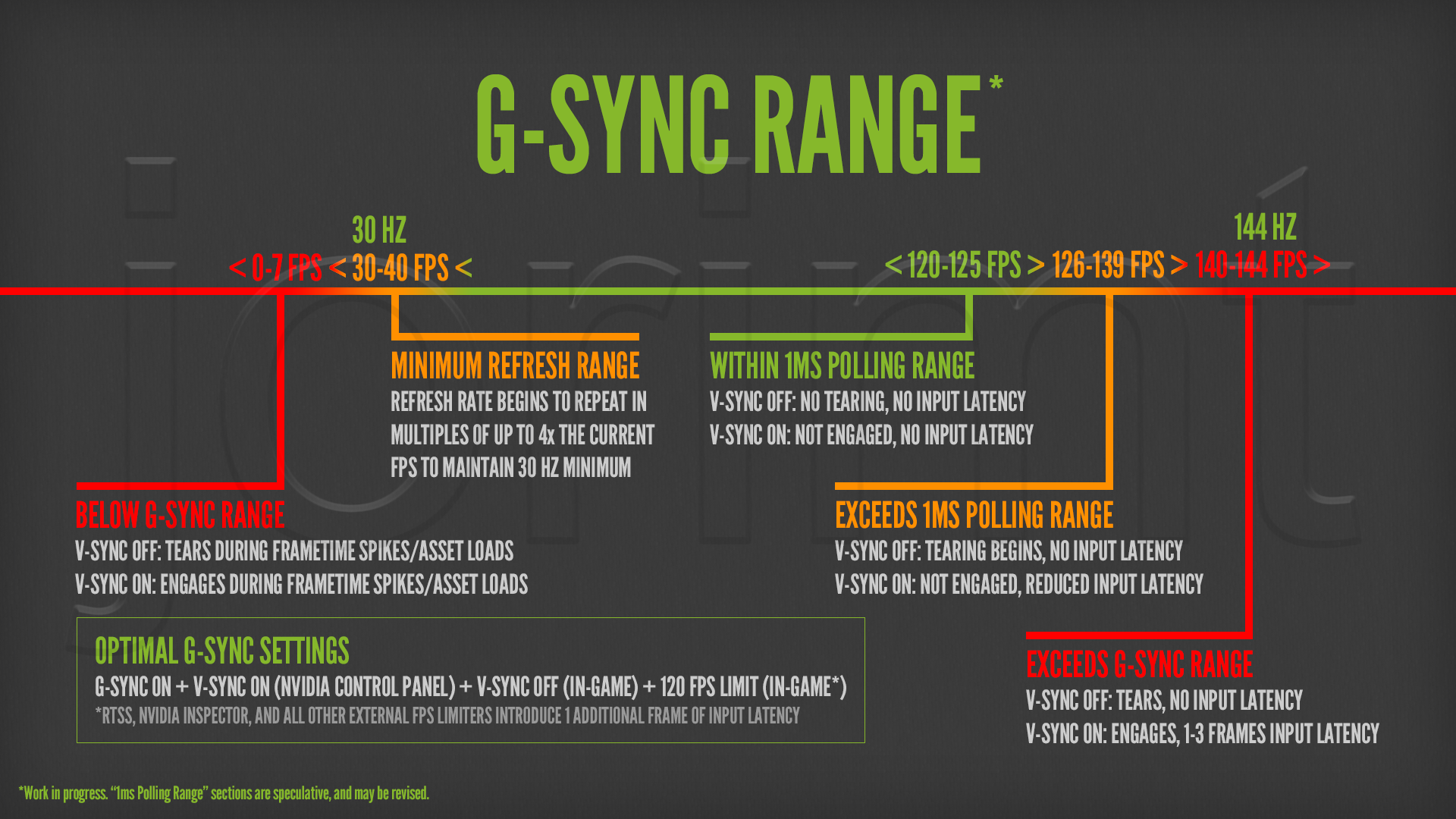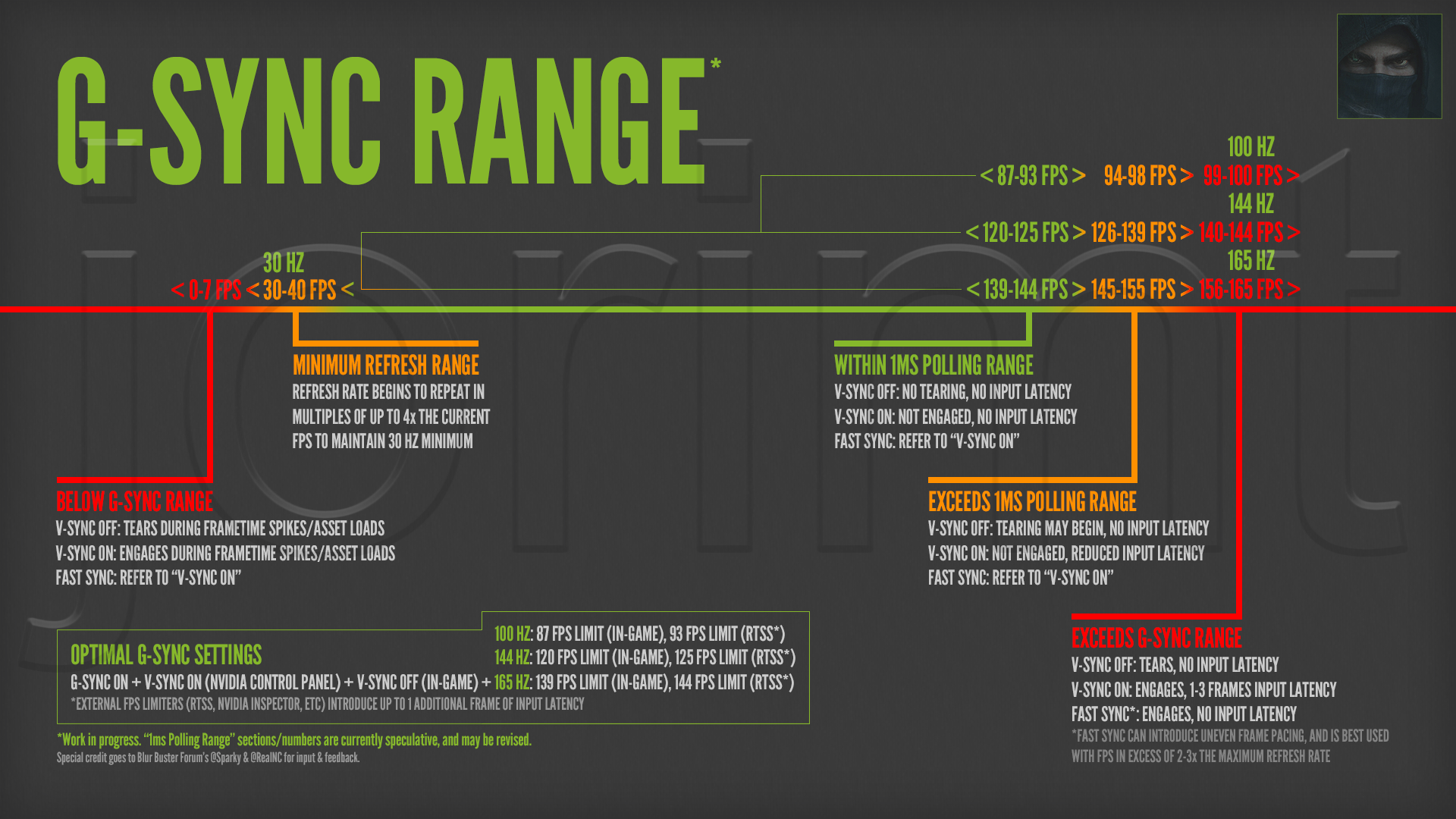er, no. Strobing is backlight pulsing, which is called ULMB and various other names, and isn't normally available while g-sync is active, though there is a hack that enables it. In general it's just repeated frames, tweening works though I haven't seen it used. I believe g-sync does the repeating from its own onboard memory, so the more specific term is 'panel self refresh'.jorimt wrote:Alright, so what I'm calling "tweening" is called "strobing," and it actually begins at 40 fps and below, correct?
That's only true for a handful of frames, a fps cap of 150 on 144hz would take less than a second to get up to 5 frames of latency. If you want to eliminate tearing you're limited to displaying 144 frames per second, and if your cap is over that, what happens to the extra frames? You can either drop them(fast sync, adds a random delay between 0 and 1/framerate), or you can make them wait in line to get displayed(which adds several frames of input lag). To do 144hz v-sync without tons of latency or inconsistent latency you'd need a synchronous framerate cap early in the render chain, to hold up the game engine until the next frame gets displayed. Sort of like stop lights on freeway on-ramps that keep the freeway from getting gridlocked.If so, I can reflect that on the chart easily. I know the strobing method used is akin to older 60Hz TVs with so-called "120Hz" or "240Hz" modes to repeat the current refresh in certain intervals (most use black frame insertion, I believe), I just didn't know the technical term, or exactly when it started with G-Sync.
As for my word choice of "polling," I'm simply pulling it, yet again, from that article:
http://www.blurbusters.com/gsync/preview2/
"We currently suspect that fps_max 143 is frequently colliding near the G-SYNC frame rate cap, possibly having something to do with NVIDIA’s technique in polling the monitor whether the monitor is ready for the next refresh. I did hear they are working on eliminating polling behavior, so that eventually G-SYNC frames can begin delivering immediately upon monitor readiness, even if it means simply waiting a fraction of a millisecond in situations where the monitor is nearly finished with its previous refresh.
I did not test other fps_max settings such as fps_max 130, fps_max 140, which might get closer to the G-SYNC cap without triggering the G-SYNC capped-out slow down behavior. Normally, G-SYNC eliminates waiting for the monitor’s next refresh interval:
G-SYNC Not Capped Out:
Input Read -> Render Frame -> Display Refresh Immediately
When G-SYNC is capped out at maximum refresh rate, the behavior is identical to VSYNC ON, where the game ends up waiting for the refresh.
G-SYNC Capped Out
Input Read -> Render Frame -> Wait For Monitor Refresh Cycle -> Display Refresh"
And here in a later comment:
http://www.blurbusters.com/gsync/preview2/#comment-2591
"You want to use the highest possible frame rate cap, that’s at least several frames per second below the G-SYNC maximum rate, in order to prevent G-SYNC from being fully capped out. Testing each run took a lot of time, so I didn’t end up having time to test in-between frame caps (other than fps_max 120, 143 and 300).
Technically, input latency should “fade in” when G-SYNC caps out, so hopefully future drivers can solve this behavior, by allowing fps_max 144 to also have low latency. Even doing an fps_max 150 should still have lower input lag than fps_max 300 using G-SYNC, since the scanout of the previous refresh cycle would be more finished 1/150sec later, rather than 1/300sec later.
1 is a good idea, but an in game cap is even better(1 frame lower latency). The exact number you need to cap at hasn't really been demonstrated. 2 is pointless at best, and given this thread, might do nothing but reduce the acceptable maximum refresh rate.Theoretically, the drivers only needs to wait a fraction of a millisecond at that time and begin transmitting the next refresh cycle immediately after the previous refresh finished. I believe the fact that latency occured at fps_max 143, to be a strange quirk, possibly caused by the G-SYNC polling algorithm used. I’m hoping future drivers will solve this, so that I can use fps_max 144 without lag. It should be technically possible, in my opinion. It might even be theoretically possible to begin transmitting the next frame to the monitor before the display refresh is finished, by possibly utilizing some spare room in the 768MB of memory found on the G-SYNC board (To my knowledge, this isn’t currently being done, and isn’t the purpose of the 768MB memory). Either way, I think this is hopefully an easily solvable issue, as there should only be a latency fade-in effect when G-SYNC caps out at fps_max 143, fps_max 144, fps_max 150 — rather than an abrupt additional latency. I’ll likely contact NVIDIA directly and see what their comments are, about this."
Finally, he states the polling time is "1ms" on a post in this thread:
http://forums.blurbusters.com/viewtopic ... lling#p221
"I talked to people at NVIDIA, and they confirmed key details.
The framebuffer starts getting transmitted out of the cable after about 1ms (the GSYNC poll) after the render-finish of Direct3D Present() call. That means, if your framebuffer is simple, the first pixels are on the cable after only 1ms after Direct3D Present() -- this is provided the previous call to Present() returned at least 1/144sec ago. Also, the monitor does real-time scanout off the wire (as all BENQ and ASUS 120Hz monitors does). Right now, they are polling the monitor (1ms) to ask if it's currently refreshing or not. This poll cycle is the main source of G-SYNC latency at the moment, but they are working on eliminating this remaining major source of latency (if you call 1ms major!). One way to picture this, "on the cable", the only difference between VSYNC OFF and G-SYNC is that the scanout begins at the top edge immediately, rather than a splice mid-scan (tearing)."
After reading all that, and doing my own simple tests, I found that between 120ish fps and the 144Hz ceiling, some weird stuff is going on, especially with G-Sync on + V-Sync off.
Here's the bottom line. Put yourself in the average G-Sync user's shoes. You buy a G-Sync monitor, you bring it home, plug it in, you pull up google, and you type in "best G-Sync settings." A variety of results pop up, mostly from reddit, which, on average, have two recommendations in common:
1. Set a global 135 fps cap with RTSS to avoid G-Sync ceiling and additional input lag.
2. Disable V-Sync in the control panel and in-game, since it adds tons of input lag, no exceptions.
Yup.
The beginner G-Sync user then sets his display up according to the above "instructions" (*eye roll*) and launches his game. He begins to see tearing at the bottom of the screen, and worse yet, the whole screen tears sometimes (unbeknownst to him) due to the frametime spikes that happen below G-Sync's range. He angrily pulls up the Geforce forums and either starts a "G-Sync is Broken!!!" thread, or comments in the latest driver thread, exclaiming G-Sync support is broken, and that Nvidia is legally liable.
Obviously, most of this is untrue. As we already know, a 135 fps cap may not always be enough to stop the tearing seen on a 144Hz display with G-Sync on + V-Sync off. That, and external fps caps add additional input lag (I still don't know how much :\) over in-game limiters. Secondly, G-Sync on + V-Sync on isn't broken; with a proper fps cap, it is actually preferred, and is the only way to achieve a 100% tear free experience when those frametime spikes crop up.
I simply want to clear up this misinformation once and for all.




